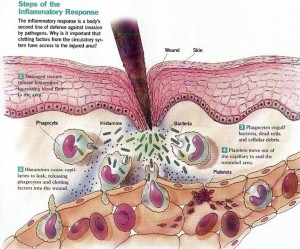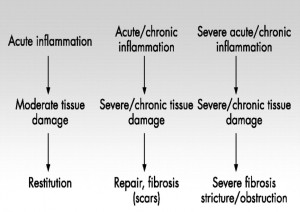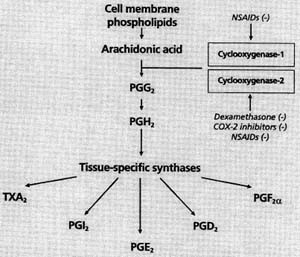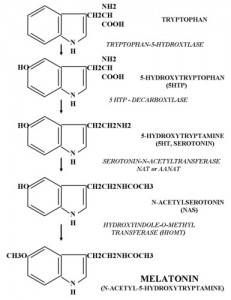Inflammation: Both friend and foe
Click here to read Dr Arien\’s article in Destiny Magazine
As foe, the common denominator present in all chronic degenerative diseases
 The word ‘Inflammation’ comes from the Latin word ‘inflamatio’, which means to inflame, to set on fire. Chronic inflammation is the fuel that flames the fire of today’s chronic degenerative diseases, (in wellness terminology, rather called health challenges).
The word ‘Inflammation’ comes from the Latin word ‘inflamatio’, which means to inflame, to set on fire. Chronic inflammation is the fuel that flames the fire of today’s chronic degenerative diseases, (in wellness terminology, rather called health challenges).
Key concept: Our bodies have an innate intelligence, an inborn ability and inclination to heal itself, using the inflammatory response as part of its natural survival healing mechanism. When we, on a physical, mental, emotional and behavioural level, interfere with this process, through our lifestyle choices, unhealthy eating choices, stressful way of living, and especially the constant stress triggers from underlying and deeply subconscious memory-emotional triggers, we sabotage and hijack this natural response, allowing insidious inflammation to become a threat, even a silent killer, rather than support, to our health and wellbeing.
Inflammation: The good, the bad and the ugly
Most of us have, and will in future, experience a sore throat, cold and flu, skin rash, insect bites, sun burn, hay fever or injury. The reason you know of this, is because of inflammation causing the typical symptoms of redness, pain, swelling and increased temperature (heat) in the affected area, ultimately leading to loss of function, if not curtailed. The acute inflammatory reaction, is a normal and appropriate response of the immune (defense) system to injury, potential disease causing organisms, such as viruses and bacteria, to rid the body of these and other toxins, and enable it to heal from injury and trauma. This process is the body’s initial reaction to cellular damage, and serves to assemble the immune system’s defence mechanisms to fight foreign invaders. It is also designed to facilitate healing by repairing damaged tissue and removing any toxins and residual debris from the body. Without the process of inflammation, the body would not be able to recover quickly from wounds, trauma, injury and infections. This type of acute inflammatory reaction is good. We need it for survival.
The inflammatory process can become a problem when the defense system becomes uncontrollable, almost like a mutiny in the ranks intent on destroying its own livelihood, or a runaway train. An overactive immune system where there’s excess and inappropriate inflammation, is typical of allergies such as asthma, eczema and hayfever, autoimmune diseases, such as rheumatoid arthritis, psoriasis and Crohn’s disease. Uncontrolled inflammation is also apparent in such conditions as arthritis, bronchitis, laryngitis, sinusitis, gastritis, colitis and appendicitis; the suffix ‘-itis’, meaning ‘inflammation of…’, the prefix identifying the specific organ or system.
Many studies reveal that hidden systemic (affecting the whole body or a particular system) inflammation may be the common denominator linking most, if not all, modern day chronic diseases, even when the connection may not be altogether obvious. These include heart disease, metabolic syndrome, obesity, diabetes, cancer, dementia, depression, Alzheimers, arthritis, even autism. This is the bad inflammation that can become really ugly if unconstrained. It is this chronic inflammation, smoldering and fermenting incessantly just below the surface of our physical awareness of it, that can become the silent killer, as it gradually destroys our cells’ function and ultimately our organs. This is also the inflammation that leads to accelerated ageing.
Steps in the healthy inflammatory response
Inflammation is a beneficial process in our bodies as a response from our immune system to an irritant, and is typically identified by symptoms of swelling and increased blood flow. These symptoms help to immobilise the area of injury as the rest of the immune system gathers around, to heal and repair. In a healthy individual, when the infection has been cleared or the tissue damage healed, the inflammation process stops and the body returns to its normal state of homeostasis.
If you step into a sharp nail, or you’re exposed to an avalanche of viruses, your immune system makes a protein called a circulating immune complex (CIC). The CIC travels to the point of injury, whether your nasal mucosa or the spot of injury on your foot, and causes pain and swelling. The pain you feel is to inform you of the injury or damage, so that you can pay attention to your body. The swelling protects the area to prevent you from moving and causing more irritation. Blood flow to the area is increased to attract and mobilise the healing agents in the blood, with antibodies and other healing cells, to begin the healing and repairing process, hence the increased temperature and redness. You are supposed and encouraged by these symptoms, to listen to your body and rest, to assist the healing process.
 Phagocytes are white blood cells in the blood, that are attracted by biochemical substances, to the area of injury. Phagocytes engulf toxins, bacteria, irritants and debris, to be broken down (through a process called lysis) inside the cells, and rendered harmless, the debris discarded. The clotting factors and platelets stop the bleeding, thereby preventing excessive blood loss. This is a normal, acute inflammatory response.
Phagocytes are white blood cells in the blood, that are attracted by biochemical substances, to the area of injury. Phagocytes engulf toxins, bacteria, irritants and debris, to be broken down (through a process called lysis) inside the cells, and rendered harmless, the debris discarded. The clotting factors and platelets stop the bleeding, thereby preventing excessive blood loss. This is a normal, acute inflammatory response.
Although the body’s reaction may be unpleasant to experience, each stage of inflammation is vital for healing and tissue repair to occur. Some of the stages that take place when the typical symptoms of an inflammatory response occur:
- Chemical signals are released by cells at the site of the injury, which attract more blood with white blood cells and other cells that fight infection
- Heat is produced by the increase of cellular activity as well as oxidation at the injury site
- Swelling occurs as blood vessels dilate, become more permeable with fluid leaking out, so that white blood cells can easily get to, and stay in the damaged area, to engulf and destroy any bacteria or debris that might exacerbate, continue or prolong the inflammation.
- Additional blood supply (which produces the characteristic redness) carries antibodies to neutralise toxic substances and microorganisms. This blood also carries oxygen and nutrients to nourish the new cells formed as replacement for the dead, injured cells and damaged tissue
- Pain, which serves to alert the injured person of the problem and protect the affected area from overuse, is due to both the swelling tissue putting pressure on nerves and a lack of oxygen to the injured tissues
In addition, many other biochemical reactions occur that involve the release of different chemical substances associated with the immune system and the regulation of inflammation. Examples are different types of prostaglandins (a group of hormone like substances that regulate various biological processes) and cytokines. Some prostaglandins activate inflammation and others shut it down once the function of the initial stages are complete. There is a very effective, harmonious balance in this pro- and anti-inflammatory prostaglandin dance that goes on until the body can return to its pre-inflammatory steady state.
Once healing is well under way, your body also produces proteolytic (meaning: breaking down proteins) enzymes to counteract and switch off the inflammation response, to return to normal homeostasis. A wound in a young child, where this process mostly goes perfectly well, heals within a few days, but can take weeks in an adult of 45. As you age, the efficacy and production of the enzymes can diminish, and the inflammation doesn’t stop when it should. The proteolytic enzymes are also responsible for clearing the debris and toxins from the damaged area, fighting off viral and bacterial infections, while breaking down excess fibrin (scar tissue). Fibrosis is scar tissue that accumulates in our bodies and over time creates so much restriction and strain on our organs that they can no longer function properly.
Usually, natural anti-inflammatory compounds accomplish the job of destroying infectious agents, clearing away cellular debris and regenerating new tissue. If, however, this response is not completely turned off, the constant low grade flow of inflammatory components in the blood, will result in prolonged tissue breakdown and scarring. Cells are then continuously injured by infection, stress, or irritation. This results in chronic inflammation.
A comparison between acute, acute to chronic and chronic inflammation
Chronic inflammation
What starts as a normal healthy immune response, turns into an extended, out-of-control reaction that destroys cells and tissues of the body, becoming chronic and paving the way for degenerative disease and accelerated ageing. In the case of autoimmune disease, the immune system response is so out of balance, that instead of attacking the source of the inflammation, it attacks and destroys its own perfectly healthy tissue.
When the body has to maintain this defensive posture, the hyper alert immune state and blazing inflammation, exhaust the body’s energy and resources. The body’s ability to function optimally is hampered, as organs and systems gradually start to break down. This hidden inflammation is the root cause of chronic diseases.
Most doctors and scientists agree that the initial manifestation of virtually every illness known, is chronic inflammation inside and around the cells. This silent, chronic inflammation does not have the typical symptoms of acute inflammation (redness, swelling, pain, increased temperature/heat) and can persist unnoticed for weeks, months, years, or even a lifetime, only manifesting as a general malaise, tiredness and lack of vitality. Eventually symptoms might appear, often at a time when too much damage, with severe loss of function, has already occurred. This is why chronic inflammation is sometimes referred to as the silent killer.
Chronic inflammation has been associated with diabetes, high blood pressure, cancer, heart disease, obesity, depression, and dementia. The overactive immune response associated with chronic inflammation results in common conditions like allergies, rheumatoid arthritis, autoimmune diseases and asthma. In the case of asthma, persistent inflammation exists in the lungs. This ongoing irritation leads to increased sensitivity of the lung tissue. The airways become over sensitive to external stimuli such as changes in temperature and environmental factors like animal hair and pollen. This increased sensitivity then lead to acute asthma when tightening of the airways make something as simple as breathing difficult. Allergy symptoms include common chronic inflammatory reactions such as rhinitis (inflammation of the nose), sinusitis (inflammation of the sinuses) and asthma (inflammation of the airways). Chronic inflammation is also the culprit behind arthritis (inflammation of the joints), dermatitis, acne, eczema and digestive disorders such as irritable bowel syndrome (spastic colon) and gastritis.
Depression is also linked to inflammation. A study conducted at the Emory University School of Medicine, found that psychological stress leads to an excessive inflammatory response in people. Their findings published in the American Journal of Psychiatry showed that individuals with depression are more likely to develop an inflammatory response due to the emotional disorder, compared to people who are not depressed.
The inflammation connection in obesity, metabolic syndrome and high insulin levels
High insulin levels increase the production of arachidonic acid, a fatty acid, that leads to the creation of pro-inflammatory prostaglandins. Unfortunately, it also inhibits the production of anti-inflammatory prostaglandins.
Another causal factor of both insulin resistance and systemic inflammation is the fat cells that accumulate around the abdominal organs and stomach area. Research has shown that these types of fat cells, which increase in size rather than number, generate huge quantities of inflammatory substances called cytokines. Various scientific, medical and nutritional journals mention this connection between high levels of the cytokine inflammatory markers, raised insulin levels due to blood sugar imbalance and obesity induced inflammation.
Metabolic syndrome (Syndrome X; insulin-resistance syndrome) has existed in various forms, and with many definitions, for more than ten years. It consists of a constellation of metabolic abnormalities with increased risk of cardiovascular disease and diabetes mellitus, and has now been defined in a collaborative attempt between the International Diabetes Federation, American Heart Association, National Heart, Lung and Blood Institute, World Heart Federation, International Atherosclerosis Society and the International Association for the Study of Obesity as consisting of the following :
- Increased waist circumference
- Increased triglycerides
- Reduced HDL cholesterol
- Elevated blood pressure
- Increased fasting glucose
Addressing the cause of chronic, hidden inflammation
It is important, first of all, to identify the triggers for inflammation. Then the body’s natural immune function can be restored through various measures to help it return to optimal conditions.
Some of the most common underlying triggers or causes of chronic inflammation:
- The single leading inflammatory trigger is the consumption of unhealthy food, high in refined sugar and flour, trans and hydrogenated fats, alcohol, artificial ingredients, and especially artificial sweeteners containing aspartame. Packaged and processed foods, especially those loaded with hormones, antibiotics, colourants and preservatives are also a major cause of inflammation
- Nutritional deficiencies, especially the B-complex vitamins, vitamin C, E and D, minerals zinc, boron, selenium, calcium and particularly magnesium, and omega-3 fatty acids
- Prolonged emotional stress (distress), where toxic inflamed emotions can literally act as triggers for inflammation (Note to editor: suggest I write an article on epigenetics)
- Environmental allergens such as pollen, moulds (mildew/fungi), dust, and so on. These are harmless substances that trigger the hyper reaction in the immune system to cause an exaggerated inflammatory response.
- Environmental toxins such as mercury, pollution and pesticides
- Food allergens, causing both immediate and delayed allergies, such as wheat (gluten), dairy, eggs, yeast, corn, peanuts, citrus, soy, shellfish and nuts.
- Repeated infections or chronic low grade infection with viruses, bacteria, yeast, parasites
- Sedentary lifestyle with lack of exercise
- Excess weight around the abdomen
- High cholesterol, especially triglycerides and LDL, with low HDL
- High C-reactive protein (CRP)
- Prolonged physical trauma and injury
- Sleep deficiencies (less than seven hours a night)
- Age related tissue breakdown
People with poor quality sleep or sleep deprivation, have increased levels of interleukin-6 (IL6), the chemical that causes inflammation throughout the body. Our biological clock and magnesium status are linked, and sufficient magnesium is important for the function of the pineal gland and the hormone it secretes, melatonin. Magnesium provides a calming effect that allows for deeper relaxation and better sleep. Melatonin levels reach a maximum after 6 hours of sleep, and it is during this period that optimal restoration and recovery of all cells take place, hence sleep being essential for balancing the inflammation response.
Biochemical pathway of melatonin formation. Note serotonin along the way, as well as tryptophan and 5-hydroxitryptophan. These are all important deficiencies found in people with depression (refer to previous section on depression and inflammation).
The usual approach to inflammation can cause more harm than healing
Inflammation: the hidden cause of chronic disease. It’s time to integrate and understand that the human body is a whole, functioning unit and not a set of separate organs and systems, each functioning on its own.
Inflammation is not specific to any one organ, but can affect any single organ or multiple systems. An integrative approach is therefore essential. The effects of inflammation are mostly treated by the different specialists’ focus on the specific manifesting organ or system, rather than a systemic, integrative approach addressing the whole human being with the root cause of many illnesses being a systemic inflammatory response gone haywire.
In my integrative medical practice, I see many patients who are each on an average of 7-12 prescription medications, recommended by specialists in each respective field, for high blood pressure, asthma, diabetes, arthritis and depression! Then I’m told they’re feeling great because everything is controlled by the medications, that they’ve only come to me because of some work related stress and exhaustion! All of these systems are connected via the common denominator of the inflammatory response.
Typical mainstream medicine anti-inflammatory drugs, such as ibuprofen or aspirin, and steroids like prednisone or cortisone, might be useful for acute inflammation and injury, but in the long term they interfere with the body\’s own immune response and can lead to serious and deadly side effects.
The most wellknown of all anti-inflammatory drugs is aspirin, which often causes more serious problems than it alleviates. All medical practitioners receive pamphlets from pharmaceutical companies nearly every week announcing the withdrawal of countless anti-inflammatory drugs from the market, due to serious side effects! We cannot wait for the drugs to be removed before we stop using them. Most pain and anti-inflammatory medications are not safe, and even over the counter (OTC) pain medications can be harmful.
These medications effectively suppress inflammation by blocking key enzymes (COX 1 and COX 2) responsible for the manufacture of prostaglandins that tend to promote inflammation and pain in the body. This can provide some short term relief, but over the long run, these drugs can become harmful to the body. Besides having adverse side effects (including intestinal bleeding, kidney and liver damage), anti-inflammatory drugs and steroids such as cortisone and prednisone, block both pro-inflammatory and anti-inflammatory prostaglandins, thus interfering with the body’s own immune response and ability to heal and repair itself.
 NSAIDs: non-steroidal anti-inflammatory drugs (e.g. aspirin, ibuprofen) block Cox 1 &2 to prevent the arachadonic acid conversion to pro-inflammatory prostaglandins. This is fine for the acute response, but ultimately also block the anti-inflammatory pathways, thereby preventing the natural balance in prostaglandin synthesis.
NSAIDs: non-steroidal anti-inflammatory drugs (e.g. aspirin, ibuprofen) block Cox 1 &2 to prevent the arachadonic acid conversion to pro-inflammatory prostaglandins. This is fine for the acute response, but ultimately also block the anti-inflammatory pathways, thereby preventing the natural balance in prostaglandin synthesis.
Dexametasone and prednisone are steroid anti-inflammatories in the cortisone group. These also suppress pro- and anti-inflammatory prostaglandins.
Always consider underlying inflammation: a simple blood test can sound the red alert, and maybe save your life
Heart disease is one of the most common health challenges among men and women. Cardiovascular disease is being redefined as an inflammatory disease of the blood vessels. Blood tests are available which measure levels of C-reactive protein (CRP), a protein molecule produced in the liver in response to inflammation. Elevated CRP levels can indicate a high degree of systemic inflammation in the body.
This clinical marker of inflammation is now considered an even more accurate early indicator of the risk of heart disease than cholesterol or triglyceride levels. According to the American Heart Association, studies have found that the higher the hs-CRP level (hs = high sensitivity type of CRP test), the higher the risk of having a heart attack. In a study done with a population of elderly people who were considered to be generally healthy, those who had the highest levels of CRP as well as Interleukin-6 (another marker of systemic inflammation) were 260% more likely to die within a four year period than those with low levels of inflammatory markers.
Studies also show that the longer a person has elevated levels of CRP, the greater their chance of developing some form of chronic disease. The presence of inflammation, indicated by elevated CRP markers, is also found in other common health challenges such as diabetes, cancer, Alzheimer’s, Parkinson’s, allergies, asthma, fibromyalgia, irritable bowel syndrome, eczema and autoimmune disease.
Conclusion
Rather than using OTC or prescription drugs that block, suppress or inhibit key enzymes and interfere with natural tissue healing and rebuilding, it is far better to support the body’s innate natural healing ability, by allowing the immune system to remain in balance. You can choose to take self-responsibility for your health, by providing the right conditions for homeostasis, inner balance and harmony. When the proper balance of key nutrients are restored through eating the right type of foods, taking the correct supplements and herbal remedies, while managing your stress levels, the body can easily recover its natural ability to use and control inflammation. Relax, let go of all the old stuff, the heavy rocks called the past that you carry in your backpack, and move into a healthier future!
Click here to read my article on preventing and managing inflammation, naturally!
References and further reading:
- Health & Happiness, Dr Arien van der Merwe.
- Stress Solutions, Dr Arien van der Merwe.
- The Inflammation Syndrome, Jack Challem
- Stopping Inflammation: Relieving the Cause of Degenerative Diseases, Dr Nancy Appleton
- Inflammation: The Match that Lights All Disease, Steven Horne and Dr Kimberly Balas
- The Ultra Mind Solution, Dr Mark Hyman

